Can Democrats Survive the Looming Crisis in New York City’s Outer Boroughs?
The multiracial working class and the white ethnic middle class are fleeing the Democratic Party, undermining its strength in Albany and imperiling its ability to compete statewide.
In the midterm elections, Republicans fared much better in New York than they did in most parts of the country, delivering strong performances up and down the ballot. In the governor’s race, Long Island congressman Lee Zeldin came within a few points of unseating Kathy Hochul, the Democratic incumbent who succeeded to the post following the resignation of Andrew Cuomo. Despite being well to the right of most New Yorkers on a variety of high-salience issues – such as abortion, gun control, and the legitimacy of the 2020 presidential election – Zeldin had the best showing of any Republican candidate for statewide office in decades.
In the race for Congress, the GOP picked up four seats in New York, allowing them to recapture the House of Representatives. The party now holds eleven House seats in the Empire State, which is the most they’ve held since 2002. The GOP also took out three Democratic incumbents in the State Senate and another three in the State Assembly, and they came close to ousting several more in both chambers. Democrats actually held up alright in the State Senate compared to previous cycles, but they now hold fewer seats in the assembly than at any time since 2012, and they’re on the brink of losing their legislative supermajorities.
How did Republicans do so well in a liberal state like New York, especially with a culture warrior like Zeldin at the top of the ticket? According to the New York Times, the answer is “a suburban revolt over crime and quality of life.” From their Sunday edition, November 27th, 2022:
“Amid a torrent of doomsday-style advertising and constant media headlines about rising crime and deteriorating public safety, suburban swing voters…helped drive a Republican rout that played a decisive role in tipping control of the House.
From Long Island to the Lower Hudson Valley, Republicans running predominantly on crime swept five of six suburban congressional seats…that encompass some of the nation’s most affluent, well-educated commuter towns.
The numbers were stark. New York’s major suburban counties around the city…all shifted between 14 and 20 points to the right…helping [Zeldin] turn a long-shot bid into the state’s closest race for governor in 30 years.”
The paper of record wasn’t the only publication running with this idea; similar claims appeared in many prominent organs of the local and national press. While some of them acknowledged that Republicans made gains in New York City as well, they tended to downplay the impact that those gains had on the midterms. For example, the New York Times noted that the city “remained overwhelmingly blue,” while the Albany Times-Union reported that strong Democratic turnout in Manhattan and Brooklyn helped insulate Hochul from a red wave in the suburbs.
But if you ask me, this interpretation of New York’s midterm results doesn’t stand up to scrutiny. To see why, let’s take a look at the outcomes of the last three governor’s races in three different areas of the state: 1) New York City, 2) the suburbs of New York City, defined as Nassau, Suffolk, Westchester, and Rockland counties, and 3) upstate New York, defined as the other fifty-three counties in the state.
The first issue with the suburban revolt narrative is that the suburbs don’t account for most of the decline in the Democratic margin of victory between 2018 and 2022, which is the comparison around which the narrative revolves. True, the suburbs did swing twenty-two points toward the GOP, but the swing in New York City was a whopping twenty-seven points. As a result, Hochul’s performance in the city reduced her statewide margin by eight points relative to 2018, while her performance in the suburbs reduced it by only six. Notably, the Republican stronghold of upstate New York moved just two points to the right and had a negligible impact on the race.
Hochul also suffered from a shift in the geographic distribution of the electorate. In 2018, thirty-five percent of all votes cast in the governor’s race came from New York City, twenty-four percent came from the suburbs, and forty-one percent came from upstate. In 2022, the distribution was thirty percent from New York City, twenty-six percent from the suburbs, and forty-four percent from upstate. The city’s decline as a share of the electorate – a product of flagging turnout in the five boroughs, not a turnout surge anywhere else – knocked another two points off Hochul’s statewide margin relative to the previous midterm cycle.
When you add it all up, the suburbs account for just over a third of the decline in the Democratic margin of victory between 2018 and 2022. The people of New York City, through a combination of defection and abstention, account for most of the rest. In my view, this pretty much dispenses with the claim that the suburbs “fueled New York’s seismic tilt toward the GOP,” as the New York Times has argued. But setting aside the question of its effects, what about the idea that the suburban turn to the right was caused by tabloid hysteria over “rising crime and deteriorating public safety?”
This brings us to another issue with the suburban revolt narrative, which is that it fails to consider other key factors that likely contributed to this outcome. For starters, the national environment was much better for Democrats in 2018 than it was in 2022. True, the party held up pretty well last year in most parts of the country, but Hochul wasn’t riding a historic blue wave in the same way that Cuomo was four years earlier. How much did that wave boost his performance? Notice that while the suburbs swung twenty-two points toward the GOP last year relative to 2018, the swing was only twelve points relative to the more appropriate benchmark of 2014.
Next, consider how much of this so-called revolt took place in Suffolk County. While Zeldin’s wins in Nassau and Rockland counties netted him 67,000 votes in total, Hochul made up for this deficit by netting 68,000 votes out of Westchester County alone. Thus, Zeldin’s entire margin out of the suburbs – indeed, his very claim to having won them – came courtesy of the 94,000 votes that he netted from Suffolk, where he was the incumbent congressman of nearly a decade and a two-term state senator before that. As a lifelong resident of Buffalo and the first upstate governor in over a century, Hochul’s connection to the area was more or less nonexistent.
In summary, the suburbs are responsible for around one-third of the decline in the Democratic margin of victory between 2018 and 2022. Taking into account the rightward drift of the national environment over this period and the home field advantage that Zeldin enjoyed against an unelected, upstate incumbent, I’d estimate that no more than one-half of this one-third can reasonably be attributed to matters of public policy, including “crime and quality of life.” Hochul certainly underperformed in the suburbs, but in my opinion, reports of a revolt have been greatly exaggerated.
Unfortunately for Democrats, Zeldin’s success in New York City isn’t as easy to explain away. Notice that while the city swung twenty-seven points toward the GOP between 2018 and 2022, the swing was still nineteen points relative to 2014. Moreover, while citywide turnout modestly declined between 2018 and 2022, it was still way up relative to 2014. This means that even after selecting an appropriate benchmark for evaluating last year’s results, we’re still left with an impressive swing toward the GOP that can’t be written off as low turnout. Zeldin didn’t have any home field advantage goosing his numbers in the city either.
To make sense of the city’s turn to the right, let’s break down the results of the last three governor’s races in each of the five boroughs. A few clues jump out immediately.
First, Manhattan and Staten Island – the wealthiest and second-whitest borough and the whitest and second-wealthiest borough, respectively – contributed the least to Zeldin’s urban success. On the one hand, Manhattan liberals remained fastidiously loyal to Hochul, who earned more or less the same share of their vote that Cuomo did. On the other hand, conservative Staten Island swung harder to the right than any other borough, but its impact on the race was minimal due to its relatively sparse population. Whatever their motives, the city’s wealthiest whites weren’t much of a factor one way or the other.
Second, Zeldin considerably improved Republican fortunes in the Bronx, the poorest and least white borough in the city. Granted, turnout is notoriously low in the Bronx, so this didn’t do all that much for his citywide margin. Still, the inroads that he made in the borough are significant on their own terms. As Michael Lange pointed out, the Bronx was once the bluest county in New York, a title that now belongs to Manhattan. Such a shift is consistent with the evolving class character of the Democratic and Republican coalitions, a topic that this newsletter has covered in some detail at both the local and national levels.
Third, Brooklyn and Queens – the most populous and diverse counties in the state – contributed the most to Zeldin’s urban success. Each one provided him as much of a boost as the other three boroughs combined, and together, they’re responsible for almost two-thirds of the growth in his citywide margin relative to previous cycles. While the white ethnic middle class in Brooklyn and Queens could have moved even further to the right, the scale of Zeldin’s gains suggests meaningful improvement with the multiracial working class as well. The question is: can we tell which dynamic had a greater effect on his performance?
Well, not exactly. To calculate the impact of particular geographic areas, we had to know the overall geographic distribution of the electorate, which was easy to derive from the results alone. But to calculate the impact of particular demographic groups, we’d have to know the overall demographic composition of the electorate, which is impossible to derive from the results alone. Thus, it isn’t prudent to characterize the impact of demographic groups in the same way that we characterize the impact of geographic areas (e.g., “Zeldin’s gains among whites account for X percent of the growth in his citywide margin.”)
That being said, it’s certainly possible to get a sense of how different groups voted by analyzing returns from precincts where those groups are heavily concentrated. Rather than labor through this exercise for all five boroughs, I’d like to present a case study of one in particular that I’m confident will be illuminating.
According to the Census Bureau, Queens is the most racially diverse county in the continental United States. To find somewhere more diverse, you have to fly to Hawaii. Whites, Asians, and Hispanics each represent about a quarter of the local population. Blacks represent about fifteen percent, with the remainder claiming mixed racial ancestry. The latest figures show that the Asian and Hispanic shares of the population are trending upward, while the white and black shares are on the decline. That adds up to big problems for the Democratic Party – at least with the way things are going.
Between 2018 and 2022, majority-Hispanic and majority-Asian precincts swung forty-four and forty-two points toward the GOP, respectively. Their turn to the right was even more decisive than that of majority-white precincts, which swung thirty-six points toward the GOP. For their part, majority-black precincts moved just twelve points to the right over the same period. Between 2014 and 2022, the swings were as follows: ten points in majority-black precincts, twenty-eight points in majority-white precincts, thirty-four points in majority-Hispanic precincts, and forty points in majority-Asian precincts.
Notice that these figures are based on data from precincts where at least half of residents share the same racial identity. When we narrow our focus to only those precincts where at least three-quarters of residents share the same racial identity – which I’ll refer to as racial enclaves – the trends are even more pronounced.
Between 2018 and 2022, Hispanic and Asian enclaves swung fifty-eight and fifty-two points toward the GOP, respectively. Their turn to the right was far more decisive than that of white enclaves, which swung thirty-two points toward the GOP. For their part, black enclaves moved just eight points to the right over the same period. Between 2014 and 2022, the swings were as follows: six points in black enclaves, forty-two points in white enclaves, fifty-six points in Hispanic enclaves, and fifty-eight points in Asian enclaves. Now that’s what I call a revolt.
Trends in Queens help shed light on Zeldin’s performance in other areas of the city. The white ethnic middle class fueled his gains on Staten Island, as well as in South Brooklyn neighborhoods like Dyker Heights, Sheepshead Bay, and Midwood. Asian voters in Bensonhurst and Sunset Park supplied more gains in South Brooklyn, while Chinatown was a rare bright spot in Manhattan. Hispanic voters helped him pick up traction in the Bronx, as well as East Harlem, Washington Heights, and Inwood in Manhattan. Citywide, the only two groups with whom Zeldin failed to make inroads were black voters and professional-class whites.
Having identified the nature of Zeldin’s urban coalition, we can now turn to the real question at the heart of the governor’s race: how did he manage to assemble it? To the extent that the media have contemplated this question, the answers that they’ve come up with are almost exclusively tied to recent events and local circumstances. Some examples include the GOP’s impressive ground game, especially in South Brooklyn; dysfunctional Democratic Party infrastructure in the outer boroughs; and of course, “concerns about crime.” But if you ask me, the deep cause of the city’s turn to the right is neither so recent nor so parochial.
This newsletter has been documenting the rightward drift of Asians, Hispanics, and the white ethnic middle class in Queens for almost two years – first in the presidential election of 2020, then in the mayoral election of 2021. This is the third straight contest in which all three groups swung dramatically toward the GOP. The charts below show the results of every major election that took place in the World’s Borough since 2014, broken down by racial enclave. Notice that after years of relative consistency, support for Democrats began to buckle in 2020 among all groups except for blacks, then continued to decline thereafter.
The same patterns have been emerging all over the country in recent years – another phenomenon that this newsletter has covered at some length. In my opinion, Zeldin’s success in New York City is primarily a reflection of these national trends, not events or circumstances unique to the governor’s race. If this keep up, Democrats’ position in the five boroughs will deteriorate even further, undermining their strength in Albany and imperiling their ability compete statewide. But will these trends actually keep up? Well you know what they say: Queens is the future.
Vulgar Marxism is very pleased to have returned from its recent hiatus, and I’d like to thank my readers very much for their patience. To help support more long-form, data-driven election analysis, please consider purchasing a paid subscription for just $5.60/month.





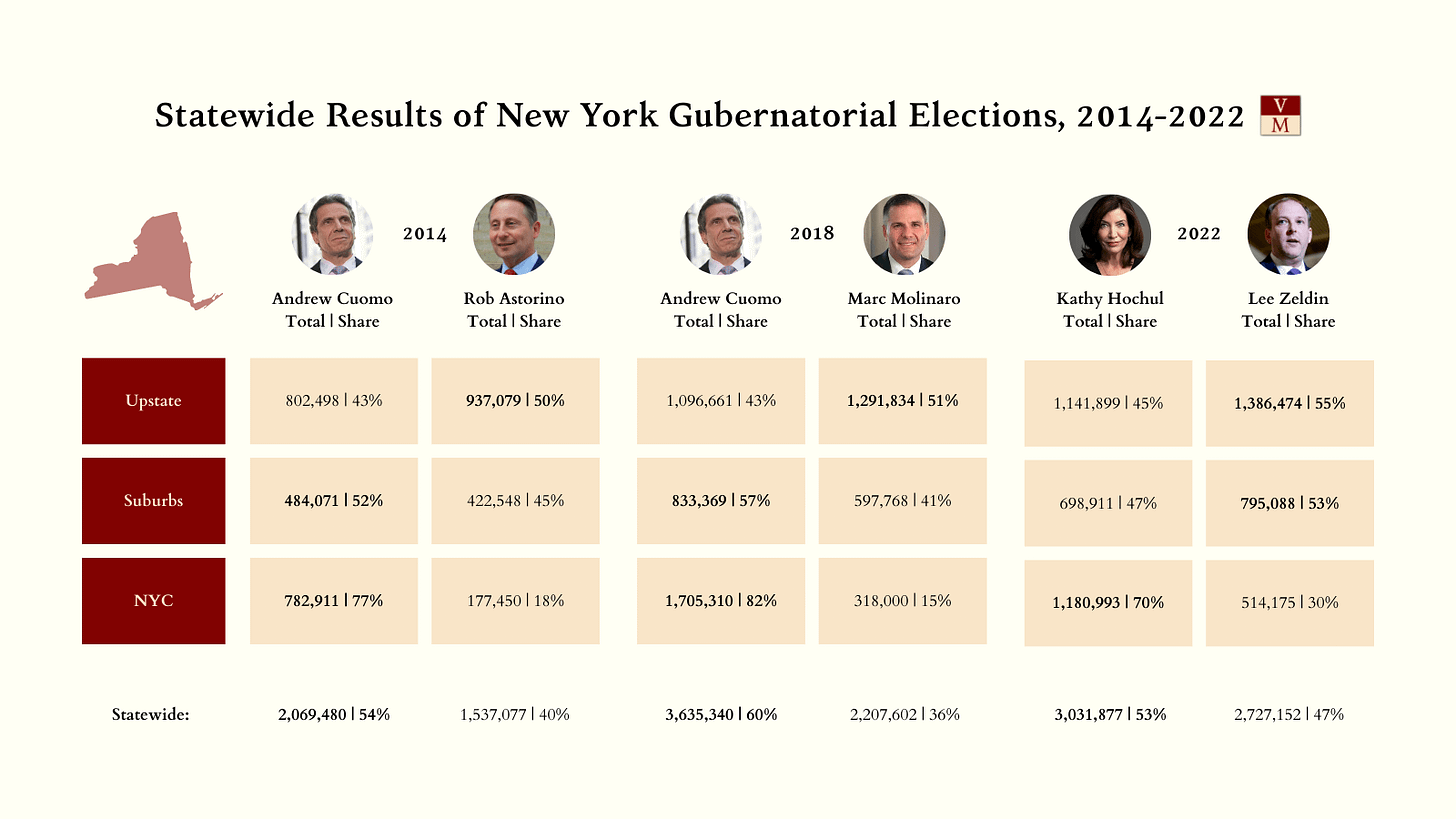
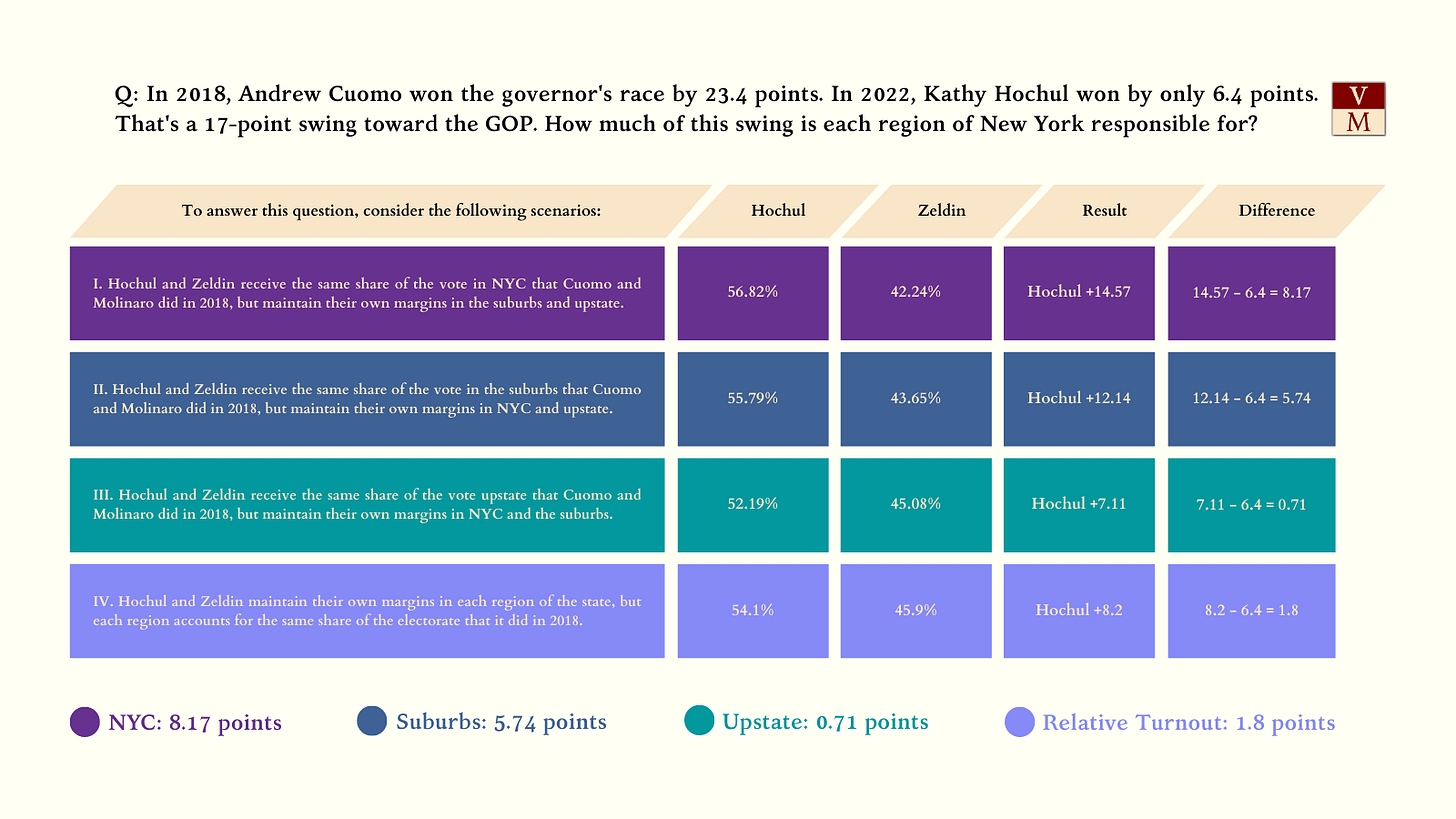

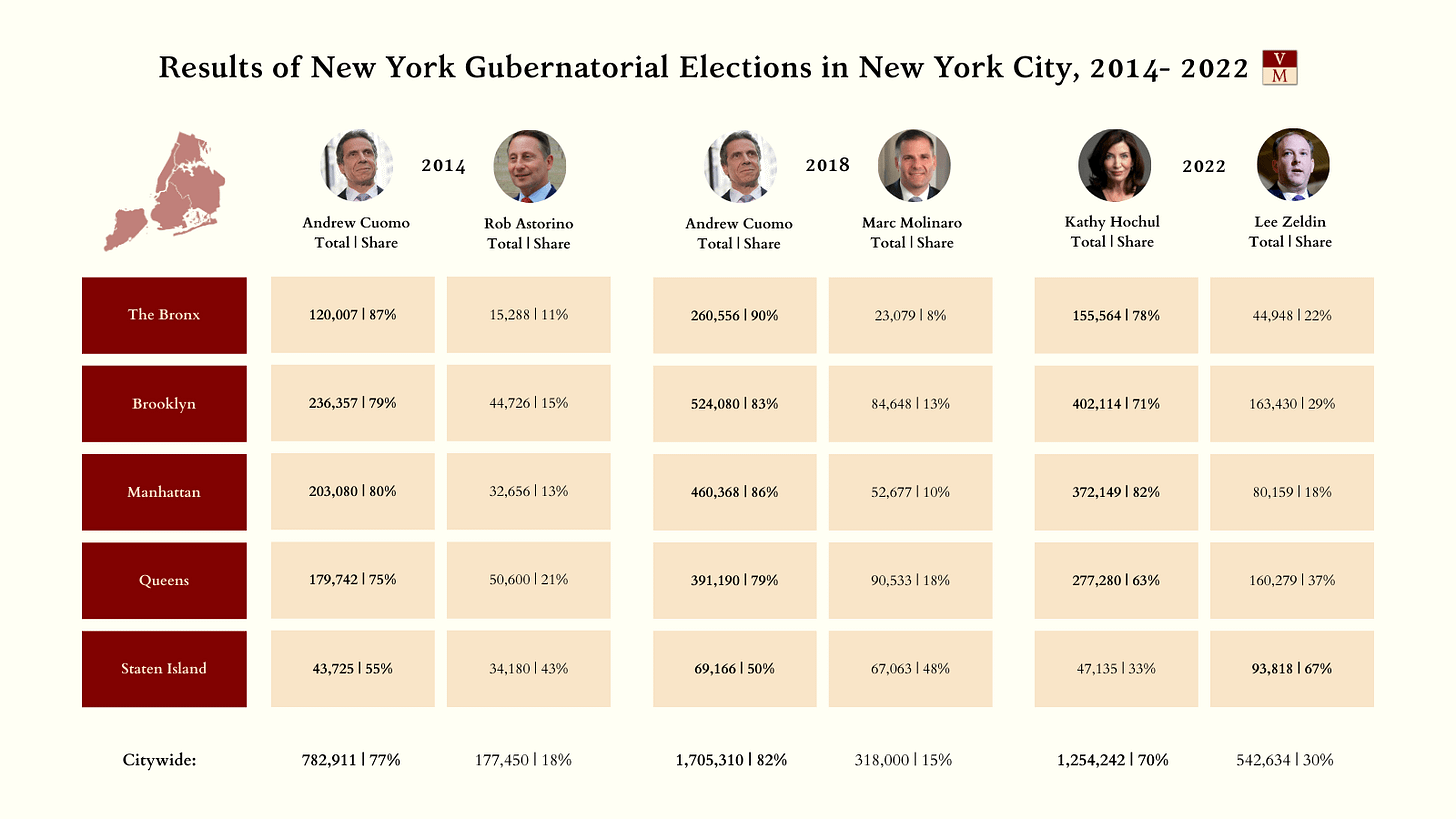



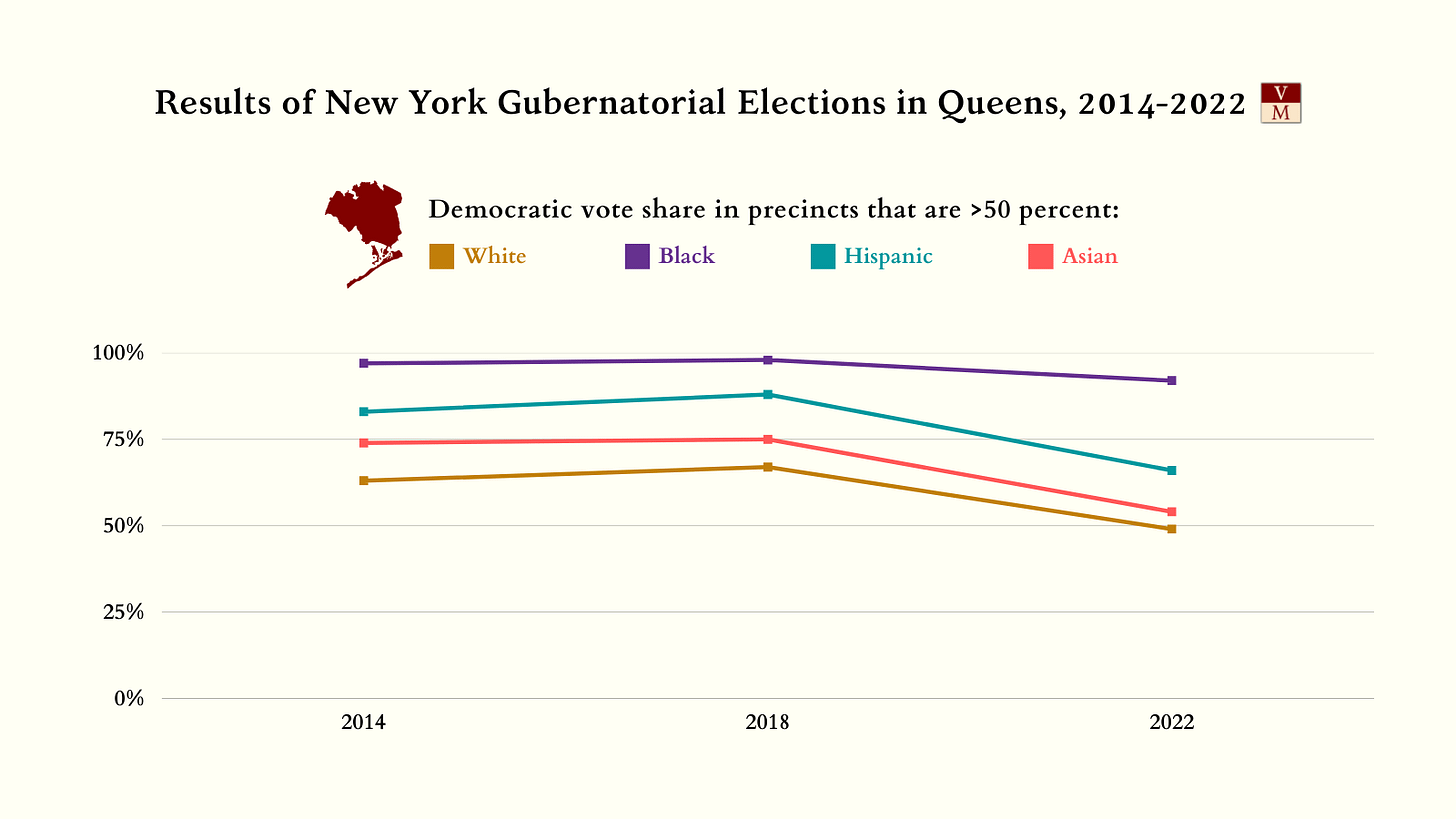


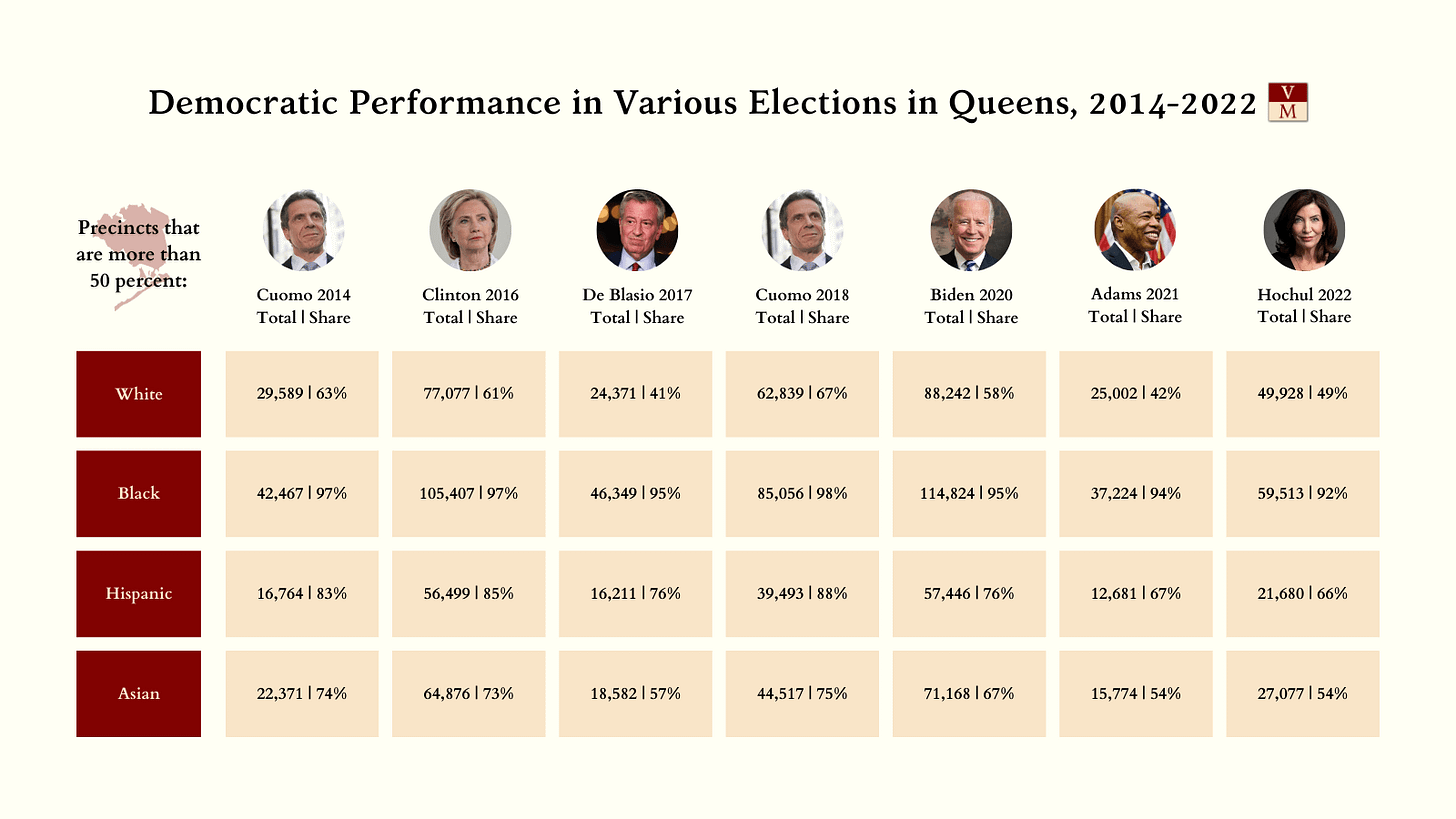


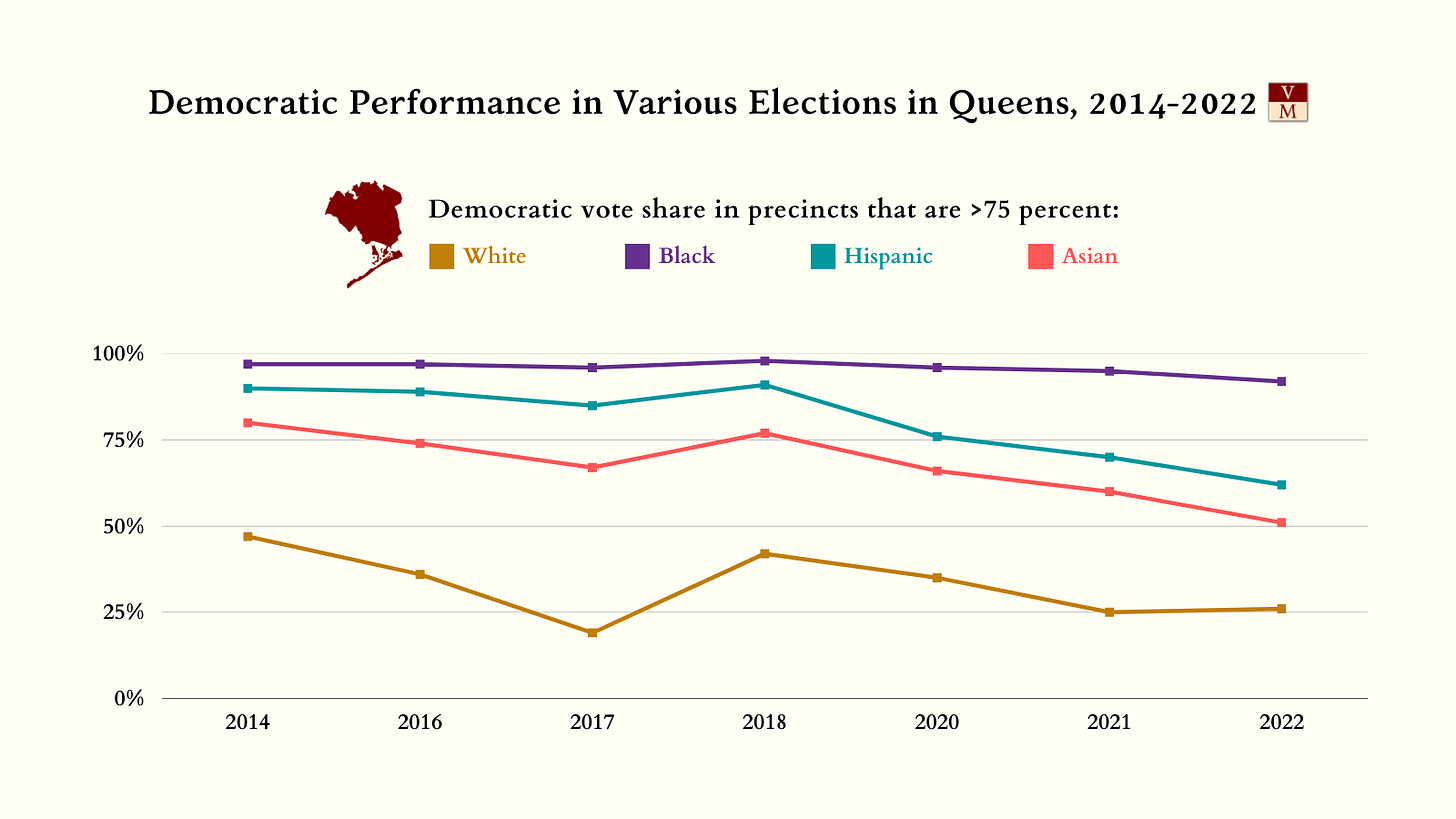
Great piece. Would be interested to do a comparison to neighboring PA, where Dems saw a very different result, and try to get a sense of what accounted for the difference.
Who would have thought spending the last 40 years validating (and passing!) Republican policy would have lead to people taking the Republicans seriously?
Perhaps if the Dems pulled their faces out of the feeding trough and actually helped the people the expect to vote for them, they might not have to worry about the clown car on the other side of the aisle.
But as Biden appoints a new grifter to be his chief of staff and Pelosi continues to endorse congressional insider trading, this seems unlikely.
Imagine being so corrupt and incompetent that you were in a dead heat with the Republicans.